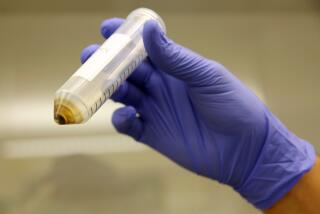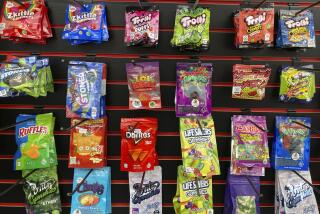Combinations of ‘safe’ chemicals may increase cancer risk, study suggests
Lots of chemicals are considered safe in low doses. But what happens when you ingest a little bit of a lot of different chemicals over time?
In some cases, these combinations may conspire to increase your risk of cancer, according to a new report.
“Many [chemicals] have the possibility, when they are combined, to cause the initiation of cancer,” said Hemad Yasaei, a cancer biologist at Brunel University in England, one of the authors of the report. “They could have a synergistic or enhanced effect.”
This is not the way regulators typically think about cancer risk when they evaluate a compound’s safety.
Normally, they test an individual chemical on laboratory animals, exposing them to progressively smaller amounts until it no longer causes malignant tumors to grow. Then they take that dose, determine the equivalent for humans, and apply what is called a “margin of safety” by declaring that some small fraction of that low dose is safe for people.
The big assumption driving the margin of safety is that a smaller amount of a chemical is less dangerous than a larger amount. (Think of the familiar axiom, “The dose makes the poison.”)
But that’s not true for all chemicals, experts say. Some chemicals, such as those that mimic hormones, may actually be more dangerous at lower doses because the human body is exquisitely attuned to respond to minute amounts of natural hormones such as estrogen and testosterone.
And regulators haven’t required testing of mixtures of chemicals at all.
“Everybody had been working under the assumption that when we tested these chemicals individually and they didn’t cause cancer below a certain dose, then we’re fine to spray that particular pesticide on your breakfast cereal before it goes into the box,” said Leroy Lowe, president of Canadian nonprofit Getting to Know Cancer and leader of the report published this week by the journal Carcinogenesis.
The new report raises questions about whether this approach is adequate.
Lowe has been making this point for years. One of his organization’s primary aims is to change the way regulators assess the health effects of chemical mixtures.
Humans are exposed to about 80,000 man-made chemicals over their lifetimes, experts say. These chemicals are in the foods we eat, the water we drink and the air we breathe.
“We live in a chemical soup,” said toxicologist Linda Birnbaum, director of the National Institute of Environmental Health Sciences, who was not involved in the new study.
The research team — a coalition of 174 researchers from 28 countries — set out to determine whether mixtures of these chemicals, at the very tiny concentrations found in the environment, could plausibly trigger the formation of cancerous tumors. They focused on 85 particular chemicals that were impossible to avoid in modern life, that were likely to disturb biological function and were not thought to pose cancer risks at the very low doses that people tend to ingest them.
“We were only looking at the tip of the iceberg,” Yasaei said.
The researchers scoured the scientific literature to understand how each of these chemicals could affect 10 important processes that are essential to cancer development. Among them: tumor-promoting inflammation, resistance to cell death and the formation of new blood vessels to feed malignant cells.
In addition, they categorized whether each of the chemicals exerted biological effects at very low doses to which humans are ubiquitously exposed. (These doses are so small that they tend to be measured in parts per million or parts per billion.)
Of the 85 chemicals researchers examined, 50 were found to affect cancer-causing processes in the body, even at very low doses.
These 50 everyday chemicals included bisphenol A (used in manufacturing plastics), triclosan (often found in hand sanitizer and anti-bacterial soap) and atrazine (a commonly used herbicide). Since each of these chemicals affects different processes that could lead to cancer — bisphenol A makes cells less sensitive to signals to stop reproducing, for example, while atrazine encourages inflammation — it’s plausible that consuming mixtures of these chemicals is riskier than consuming any one individually.
“To me, it’s not a surprise,” said Birnbaum of the NIEHS. Scientists know that small effects from many chemicals can add up to cause other diseases, she said. For instance, chemicals known as endocrine disruptors can lead to neurological, immune system and reproductive problems, among others.
Considering the safety of individual chemicals is a lot like looking at the trees, but missing the forest, Birnbaum said. When doing research to determine chemical safety, “we’ve got to start thinking more about what reality is,” she said.
This could mean sweeping changes in rules about the levels of chemicals considered safe in drinking water, food, and air.
“I’d like to see regulators and policy makers start looking at the totality of the exposure instead of one chemical at a time,” she said.
Follow me on Twitter @sasha_hl and “like” Los Angeles Times Science & Health on Facebook.






